Nicola Bennett, abstract artist
Exploring synesthesia through her art, why it’s ok for greens to clash, and when she met her chef hero Ottolenghi
Abstract painter Nicola Bennett aims to capture with paint the sensory pleasure that people experience around food—delighting in rich colors, flavors, scents, and textures. Nicola is exploring the concept of synesthesia—the simultaneous perception of multiple stimuli in one experience—so one might “see” music as a color, or “taste” a shape.
Good things happen when Nicola’s kitchen and painting studio collide. She brings figs, eggplants, mushrooms, walnuts, and many other delicious ingredients—not necessarily mixed together—into her studio and will cook and bake with them before tackling a large abstract painting conceived to be a feast for the senses.
Nicola gets her ideas from cookbooks (she’s a devotee of Yotam Ottolenghi), visits to local farms, and her collaborations with chefs. She will often share on Instagram how she’s feeding works in progress, such as with a recent walnut painting: “I’m drawing walnuts while holding them in my hands and eating them, dipped in honey.”
Both cooking and painting are about transformation, Nicola says, and that’s part of the appeal of combining them. With skill and imagination, one can transform a collection of ingredients into a deeply satisfying meal or a canvas and paint into a beloved work of art.
Nicola is based in Okere Falls, in the Bay of Plenty, New Zealand. She’s collaborated with local chefs to stage culinary and art events that highlight the interplay between her paintings and the food they inspire, or the menu items that informed her pieces.
Can you describe your process to create a specific painting?
Last summer I made an apricot painting. I started by getting a box of apricots from the South Island of New Zealand, where there are stone fruit orchards. [My job here at Palate & Palette also requires me to get fresh stone fruit from an orchard and in my case it’s Autumn Hills Orchard in Groton, MA.]
These apricots surprised and delighted me in a new way. Everything about these apricots was different from the supermarket ones, which feel sterile and cold with no personality. These otago apricots were ripe, and they’d been allowed to ripen on the tree, so their color, smell, and feel were exactly what an apricot should be. They were perfect in every way. It seemed like I could taste the sunshine.
It was like when you think you know someone close to you, but they've shown you a little surprise that you didn't know about them. That’s what I love about fruit and vegetables. There's always something different they can show you if you combine them with other ingredients or cook them in a different way. I roasted the apricots in amaretto and made this beautiful cheesecake. I enjoyed the first slice by myself at home alone. I don't get to do that very often because I live in a busy household with teenage children.
Then I was excited to make the apricot painting and was painting in the moment. I was not thinking about what I've got to do tomorrow or thinking about anything else. I was only thinking about the ingredients, the process, and the sensory pleasure and being in the now.
Establishing a connection to the ingredients you are using as your subject seems important to you.
I did a painting of mushrooms recently and met the mushroom grower. She described mushrooms as having personalities and whims and needs and said that they flourish in the right conditions, just like we do.
She was so passionate about her work that I came away from that experience inspired by the beauty of mushrooms and a bit intimidated. How am I going to portray that on a canvas? I did get there in the end and it was a huge painting—nearly 10’ x 4’. It’s my biggest painting yet.
When did you start focusing on food as your subject matter?
I was brought up thinking that the way you show your love for someone is you cook for them. My mom was amazing cook. I realized that when you make something delicious, it makes someone happy, and that can be quite rewarding. Then I spent a bit of time in France and Italy, where food is the center of their culture, their life, and their passion. I loved that meals there would last for a couple hours, with people eating and talking.
I did my master's thesis on the sensory and sensual pleasures of the handmade object. My focus was more sculptural, but it started off being about cooking and sensory pleasure. I'm still on the same investigation, 17 years later.
My master’s thesis was initially about cooking, but as I narrowed it down, it became about the experience of cooking in relation to the experience of making art. It was about heightened senses and focusing on the word haptic. I delved into experiencing an artwork through all our senses, not just with our eyes.
I've been on this journey with my artwork for a very long time, but I've only been painting seriously for the past seven years and I've only been a full-time painter for the past five years. When I was around 40, I realized I really need to do this thing that I love.
Tell me about your fig and pistachio painting.
It was a commission. Initially I got excited about the color of the ingredients in the recipe. I think it was an Ottolenghi recipe for a pavlova. Then I wanted to get to know the ingredients and cook with them.
I cooked lots of things with figs and pistachios, trying to get to know them in different situations. Then I picked a favorite one, a fig pavlova. I’ve done several paintings with figs, each inspired by a different recipe. Often, I will make a recipe a few times while I'm painting it and go back and forth between cooking and painting.
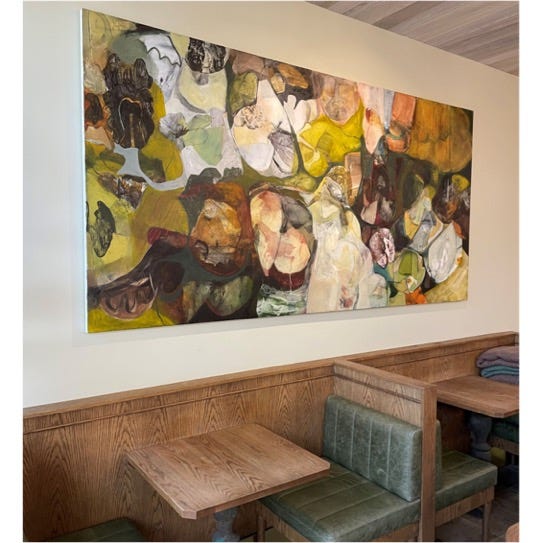
You usually start with focusing on an ingredient or combination of ingredients.
The ingredient is always the starting point, but the painting is its own thing. Once I start, I’m responding to the painting, like writing a book. You write one sentence and respond to that, until you have a whole book. A painting evolves the way it’s meant to, led by flavor and cooking, but ultimately I’m responding to the marks and the painting and letting it dictate what to do next.
I work in a way that as soon as I think about the painting needing x, y, or z, I do it straight away. I don’t let my “thinky” brain get involved and interfere and say, “Well haven’t you just used yellow, shouldn’t you try something else?” I work intuitively by passing that right or wrong voice.
It seems that you paint either very large works or small “cookbook” paintings.
The smaller “cookbook” series of paintings have the same size, weight, and feel as a cookbook. I like the idea that they are the same size as a page in a cookbook and they reflect the flavors in that recipe on that page.
You sometimes paint on food to get the right color, but do you ever use food in your paintings?
No, I've never done that [she makes the good point that actual food would degrade]. I’m obsessed with oil paints. I like this particular brand, Schmincke. It has a buttery feel between my fingers and works well for building layers of color like layers of flavor.
You've collaborated with chefs and there was one in particular involving a “forage and feast” dinner that created challenges for each of you.
I gave the chef Timo Dicker, of Terrace Kitchen, the challenge of making a dish that was black and white and one that was pink and white. Timo created a foraged dish with wild garlic, sorrel, artichoke, and spinach and challenged me to make a painting based on those ingredients. Then he created a whole menu based on paintings I had made.
What is the most underrated vegetable?
The aubergine, which you call eggplant in the states. It's this ordinary and plain, spongy, white thing that good cooks transform. I do heaps and heaps of different things with aubergine and I don't repeat the same recipe. I'm just mad keen on Ottolenghi recipes.
Gosh, I’ve done heaps of aubergine recipes. I like aubergine dumplings and aubergine parmigiana with filo, and I’ve made paintings from both of these recipes.
You actually got to meet Ottolenghi.
Yes! My ultimate goal is to create a painting for one of his restaurants. He's influenced my work so much. He did a talk and a cooking demo here, and I met him backstage. He likes lemons, so I made him a lemon cake, lemon dip with Turkish bread, and a lemon painting to express my thanks for inspiring me. He seemed really grateful and gave me a hug.
What is it about his cookbooks and his recipes that you admire?
Ottolenghi has a deep understanding of flavor and he talks about cooking in the way that I think about painting. He describes cooking as being about building layers of flavor and a process of discovery. Painting is exactly that—an intuitive way of constantly learning with a deep connection and understanding.
Do you choose your color palette at the beginning of a painting?
Loosely, but it might change along the way. I suppose there's always one color that's the star of the show [she likes green].
But sometimes if I start on a green painting, it's not purely green. It's going to have all these other color combinations. Some painters say green is difficult to paint with because it can be quite dominating. I try to make new combinations of green all the time. I even make greens clash because there are so many different types of green in nature, and we never feel like those greens clash.
I do a lot of harmonizing, so every color that's on that painting has a bit of another color in it somewhere and they have relationships to each other. That’s why a painting will work eventually because the colors are harmonized. Harmonizing is when you mix all the colors on your palette together to make a kind of muddy color. Then you mix a tiny bit of that mud with each of the colors and you’ll then harmonize each of the colors, because now they relate to each other. I never use paint straight from the tube, for this reason.
Does your way of connecting food and art attract people who might not otherwise be drawn to abstract art?
I think people can access it through the idea of how I’m showing flavor, and the way we tend to associate certain colors with flavors: red is sweet, green is sour, white is salty, and black is umami.
I love the analogy of viewing abstract art similarly to listening to birds sing. We don't know what they're saying, but we can still love their song.

You have fun titles for some of your paintings such as Everything I Need is Here and She Does What She Wants. Do you have the titles when you start or do they come at the end?
I come up with the titles at the end. She Does What She Wants came from visiting a mushroom grower. She talked about the lion's mane mushroom, and said, “She's so spoiled. She does what she wants.”
It's nice if a title can take you somewhere. We make our own associations, so She Does What She Wants might bring up an association of a relationship with a difficult woman. But for me, that title was about mushrooms [that seemed to be quite strong willed according to their farmer].
Do you look at the work of other artists to see what else is happening in the art world or as a source of inspiration?
I probably look at more food than art. I have also been doing online drawing workshops offered by the London Drawing Group. The workshops focus on art history and show the work of an artist, primarily female painters, and then we do drawing exercises. A recent workshop focused on Hilma af Klint. She was creating these incredible abstract works in the 1920s when everyone else was painting representational and highly detailed work.
Another artist I admire is Georgiana Houghton, who was doing wildly expressive work that wasn’t widely accepted in its time. [Houghton was a medium and spiritual artist who boldly displayed her abstract art in the 1870s, London, where it went largely unappreciated and misunderstood.]
What is the best advice that you've received about being an artist or about painting?
If you don't love your work no one else will.
I had a mentor who wanted me to put more effort into marketing. She told me to think of how many people there are in the world and how many paintings I need to sell to make a living. Let's say it's 30 or 40. She asked me: are you telling me you can't find 30 or 40 people in the entire world that your art can't speak to? It's your job to find those people. Once I realized that marketing is actually connecting with people and I love connecting with people, it got easier.
Lightening round questions
What food is a guilty pleasure for you? I love a craft beer and some salty crisps, which you call chips, at the end of the day. I know, it sounds really unhealthy.
Favorite breakfast. Avocado with a sprinkle of salt on sourdough toast is my all-time favorite. I also have Medjool dates with peanut butter and a cup of black coffee to get me in the studio.
What's your favorite piece of art that you own? It’s an encaustic painting I bought from another student when I was 19 and studying art. I walked into a shared studio space, felt a connection to this painting, and offered to buy it, much to the artist’s surprise. I sent her a message recently saying, did you know I've been enjoying your painting every day for 27 years?
You're hosting a dinner party for six people living or dead. Who is coming and what are you serving? Yotam Ottolenghi, Ixta Belfrage, Wayne Thiebaud, Judy Millar, Idris Murphy, and Guglielmo Castelli. I'd serve an Ottolenghi feast, a meze of loads of different things that we would eat over a long period of time while talking about color and flavor.
Do you have a painting of yours that you would never want to sell? No, I hardly ever keep any of my own work.
What's been your most captivating museum visit? Recently, I saw an exhibit of Robin White, a prolific New Zealand artist who spent a lot of time in the islands. The exhibit spanned 50 years of her creative life, and it included printmaking, drawing, and painting.

Palate & Palette menu
Here’s what I would serve if Nicola came to dinner, which she is invited to do:
All Ottolenghi recipes!
Green Gazpacho
Grilled Rhubarb with Burrata and Pink Peppercorn Oil
Grilled Broccolini and Asparagus with Green Pepper Salsa and Butter Beans
Apple and Olive Oil Cake with Maple Icing
Where to find Nicola Bennett (and you should!)
https://www.nicolabennett.co.nz




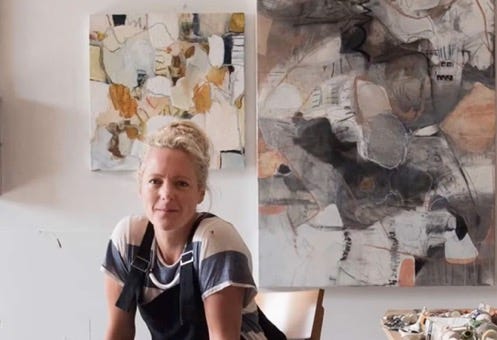



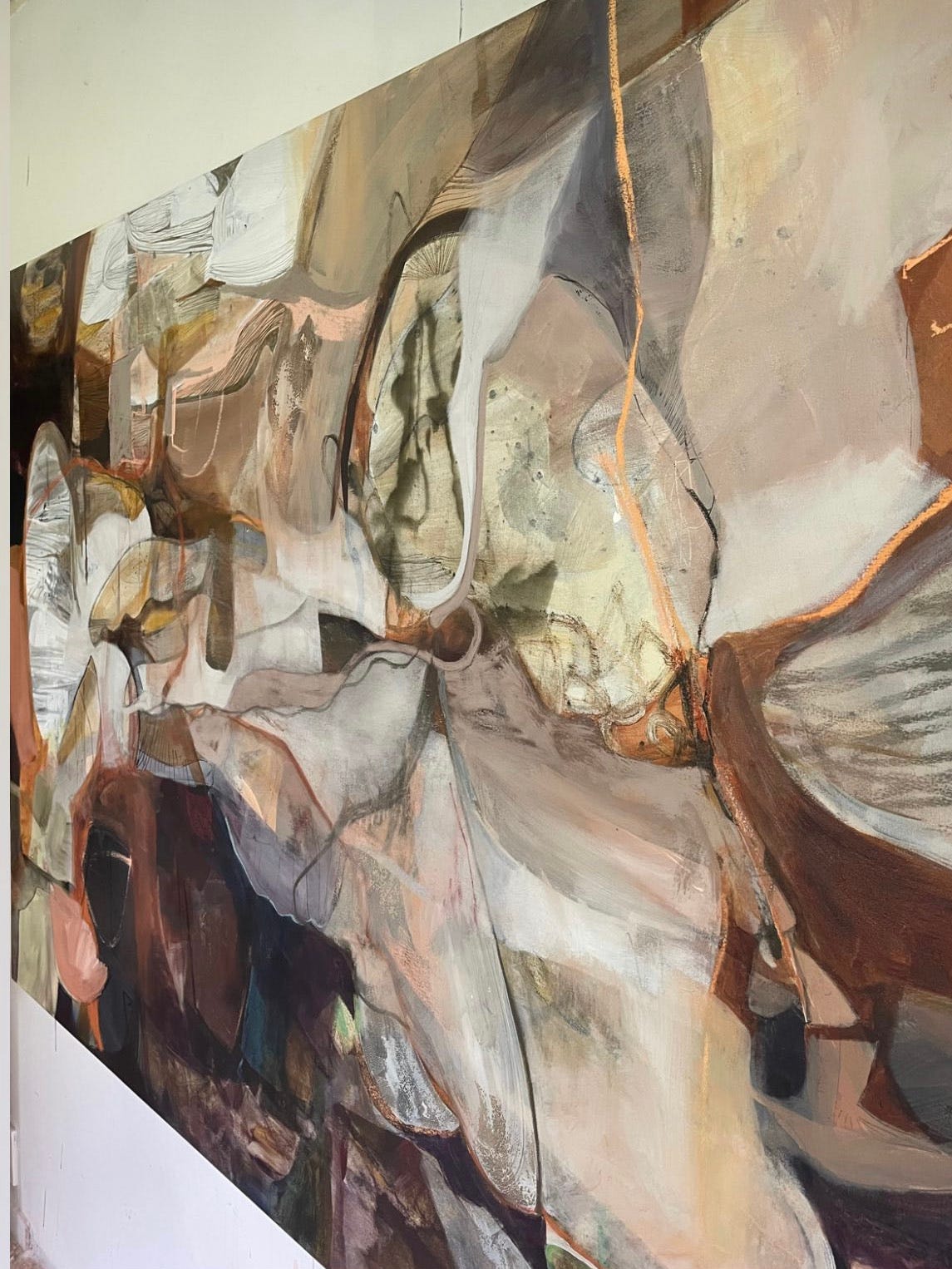


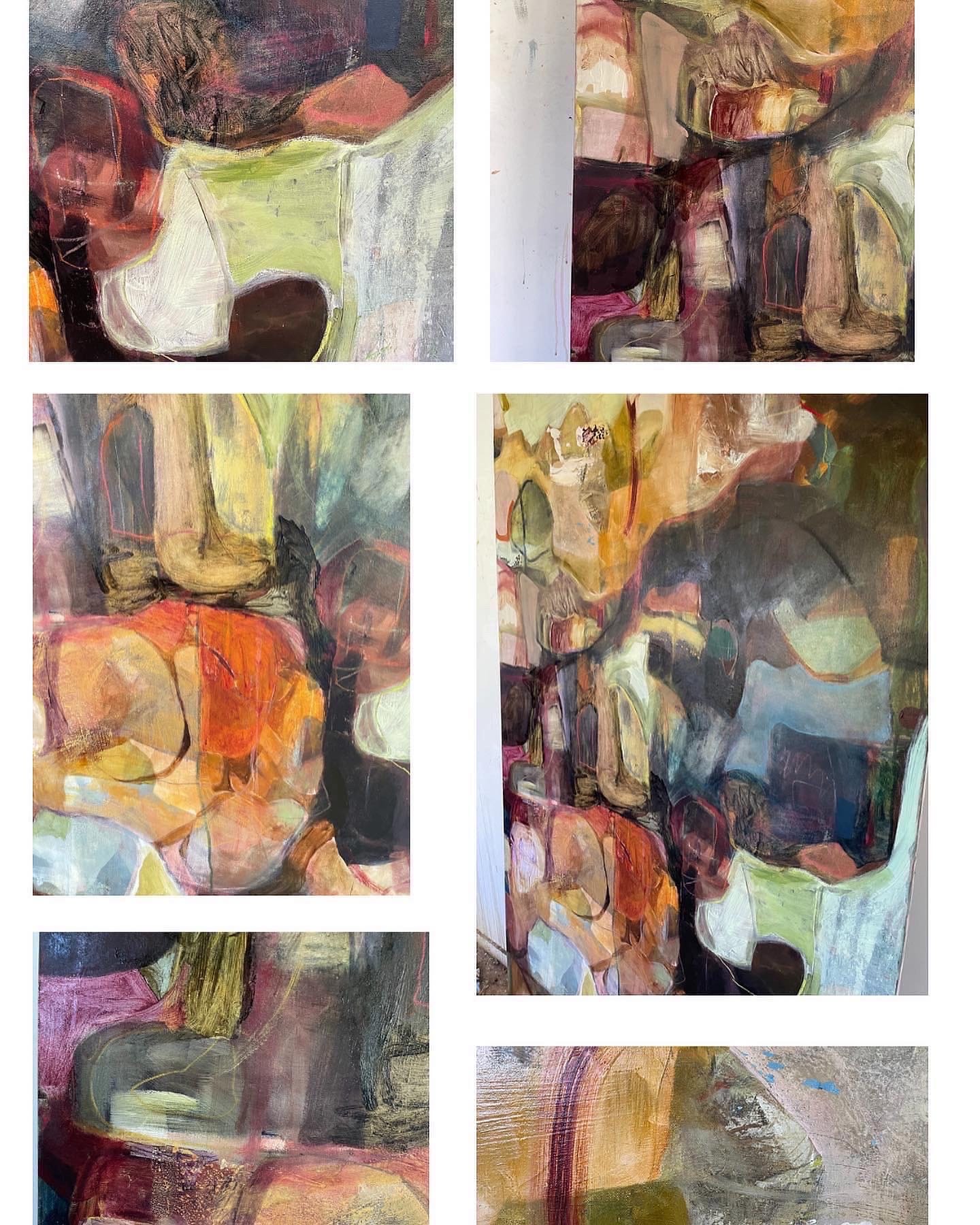





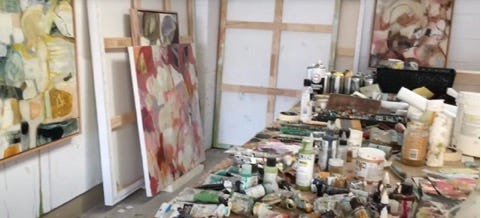
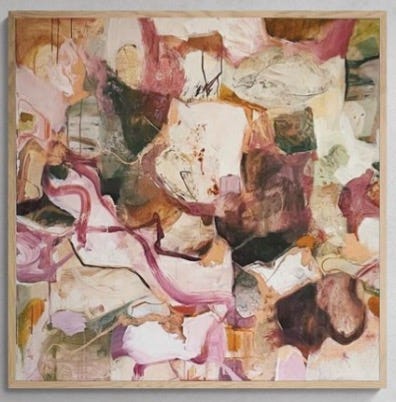
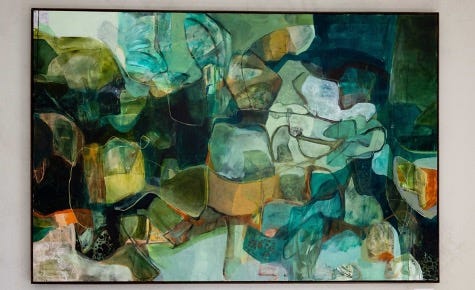
Fabulous painter and luscious write-up. Inspiring
Nicola sounds like the perfect artist for one of your Substack interviews, and it is a fascinating one. I love how she is inspired by food, and the roasted apricots in amaretto sound amazing!